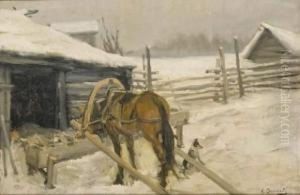Aleksandr Nikolaev. Stepanov Paintings
Aleksandr Nikolaevich Stepanov was a Russian artist born in 1776. He was primarily known for his work as an engraver and his contributions to Russian numismatics, the study or collection of currency, including coins, tokens, paper money, and related objects. He held a significant position at the Saint Petersburg Mint, which was the hub of Russian coin production.
Stepanov's life and career were closely linked to the flourishing period of Russian arts and sciences during the reign of Catherine the Great and her successors. Although he is not as widely recognized as some of his contemporaries who excelled in other forms of visual arts, Stepanov's work in engraving and numismatics was essential in preserving Russian heritage and creating a visual language for the nation’s currency. His engravings often depicted themes of national importance and were marked by a meticulous attention to detail.
The early 19th century was a time of great change and modernization in Russia, and Stepanov's works coincided with this period of transformation. He was part of a broader movement that sought to establish a distinctly Russian cultural identity, distinct from Western Europe, through the arts, literature, and other cultural expressions.
Stepanov's contributions to numismatics are particularly noteworthy. He was involved in the design and production of coins that not only served a practical economic function but also had an aesthetic value and were representative of the Russian state's power and culture. His engravings were used to create dies for coins that were then minted in large quantities, circulating throughout the vast territories of the Russian Empire.
Despite his important role in Russian art history, specific details about Stepanov's life, including his training and personal life, are not widely documented, which is not uncommon for individuals working in more specialized or technical fields of art during this era. Aleksandr Nikolaevich Stepanov passed away in 1823, leaving behind a legacy as an influential figure in the development of Russian numismatic art. His work remains a subject of interest for historians and collectors of Russian coins and medals.


